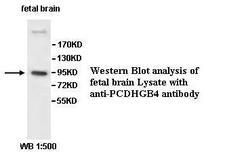order histories, retained contact details for faster checkout, review submissions, and special promotions.
Forgot password?
order histories, retained contact details for faster checkout, review submissions, and special promotions.
Locations
Orders Processing,
Shipping & Receiving,
Warehouse
2 Shaker Rd Suites
B001/B101
Shirley, MA 01464
Production Lab
Floor 6, Suite 620
20700 44th Avenue W
Lynnwood, WA 98036
Telephone Numbers
Tel: +1 (206) 374-1102
Fax: +1 (206) 577-4565
Contact Us
Additional Contact Details
order histories, retained contact details for faster checkout, review submissions, and special promotions.
Forgot password?
order histories, retained contact details for faster checkout, review submissions, and special promotions.
PCDHGB4
Protocadherin Gamma Subfamily B, 4
PCDHGB4 is a member of the protocadherin gamma gene cluster, one of three related clusters tandemly linked on chromosome five. These gene clusters have an immunoglobulin-like organization, suggesting that a novel mechanism may be involved in their regulation and expression. The gamma gene cluster includes 22 genes divided into 3 subfamilies. Subfamily A contains 12 genes, subfamily B contains 7 genes and 2 pseudogenes, and the more distantly related subfamily C contains 3 genes. The tandem array of 22 large, variable region exons are followed by a constant region, containing 3 exons shared by all genes in the cluster. Each variable region exon encodes the extracellular region, which includes 6 cadherin ectodomains and a transmembrane region. The constant region exons encode the common cytoplasmic region. These neural cadherin-like cell adhesion proteins most likely play a critical role in the establishment and function of specific cell-cell connections in the brain. This particular family member is expressed in fibroblasts and is thought to play a role in wound healing in response to injury. Alternative splicing has been described for the gamma cluster genes.
| Gene Name: | Protocadherin Gamma Subfamily B, 4 |
| Family/Subfamily: | Cadherin , not assigned-Cadherin |
| Synonyms: | PCDHGB4, Cadherin 20, Fibroblast cadherin-2, PCDH-GAMMA-B4, Protocadherin gamma-B4, Cadherin-20, Fib2, Fibroblast cadherin FIB2 |
| Target Sequences: | NM_003736 NP_003727.1 Q9UN71 |


If you do not find the reagent or information you require, please contact Customer.Support@LSBio.com to inquire about additional products in development.









